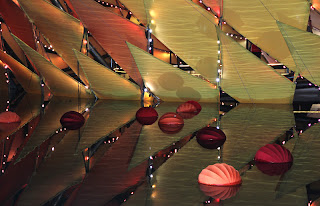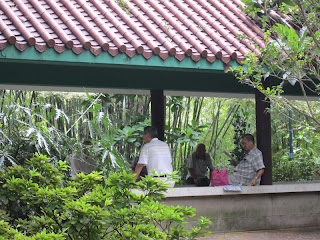Sunday, September 30, 2012
Mid Autumn Festival
The Mid Autumn Festival is a lunar harvest festival celebrated by the Chinese and Vietnamese. Mooncakes, lanterns, the moon rabbit and lady on the moon are some of the most common icons associated with this celebration. Each year in Hong Kong there are numerous lantern festivals scattered throughout the city.
The display at the Cultural Center featured lanterns based on the Terra Cotta Warriors.
And of course I had to catch a shot of my favorite warrior.
The largest of the lantern displays each year is in Victoria Park. It is a huge area with lots of smaller lantern displays, stages for performances, local vendors and the iconic lantern for that year. This year's huge lantern was a depiction of the moon.
Wandering the grounds on a warm evening is delightful. Many of the lanterns are set so that you can get up close and personal.
The grounds are lit with thousands of tiny lights that make a beautiful backdrop for the lanterns.
One of my favorites this year was a stack of red teapots.
Along the local vendor booths there was a young woman making poured sugar candy...
...and a stand selling local dried treats and remedies. They were even giving out free samples.
There was a gentleman working on his homemade candy...
...and balloon people larger than life.
The center of the park was protected by a dragon.
A beautiful lantern garden was there for resting.
And every quarter hour is marked by a light show inside the giant lantern. The music, the lights, the reflection in the surrounding pond - all put the perfect finishing touch on the evening.
Friday, September 28, 2012
The Majesty of All Under Heaven
In celebration of the 15th anniversary of the handover of Hong Kong in 1997, a very special exhibit was prepared and is now on display through November. The Majesty of All Under Heaven - The Eternal Realm of China's First Emperor is both an interactive and traditional exhibit featuring artifacts from the Qin Dynasty. The most famous of these artifacts are the terra cotta warriors and this display has the largest number ever exhibited outside of the mainland.
The exhibit actually begins even before you enter the museum. The plaza outside has a pit mural on display.
The steps up to the plaza depict one of the pits and along the garden walls small "digs" show warriors emerging from their hidden graves.
There are even some kiddie sized warriors for the little ones to enjoy.
Once you enter the exhibit hall you are completely captivated. The first area is the interactive section where you find yourself in a wall scene with a small warrior beckoning you. Once you figure out that he wants you to stand on footprints on the floor, he grows and interacts with you. There are three such scenes and also information on the history of the warriors, the Qin people and their association with horses. The next room is a holographic tour of the dig and the pits where the warriors were created in the tomb of Qin Shihuang some 2200 years ago.
The artifacts section of the exhibit displays the cultural relics and is most impressive. There are over 150 items on display and when you consider the age of these pieces (from around 221 B.C.) the craftsmanship and materials boggles the mind. Among my favorite pieces were a bell from a set of five used to herald announcements, a belt buckle made of gold and featuring a dragon and a filagree pot that is truly beautiful.
There is an actual skull on exhibit and if you look closely you can see a bronze arrow tip embedded in the left jaw.
There are many warriors on display but with the glass and the lighting getting good clear photos is a challenge. One thing that immediately catches attention is the fact that there are so many different poses and "looks" to the men. Many wear armor and it too is made from clay. Each suit of armor is comprised of individual squares chained together. I cannot fathom the work that went into even one of these warriors. Creating over 8,000 soldiers, 130 chariots, 520 horses and 150 cavalry horses along with other non military figures is said to have involved over 700,000 workers.
One of the surprises in this exhibit is the creation of the emperor's staff (housed in a separate pit) and all of the additional animals and birds.
Another featured piece in the exhibit is a bronze chariot and horses to carry the Emperor in the afterlife. This piece is less than life sized but that does not make it any less impressive.
The figures were manufactured in workshops and built in assembly line fashion with individual facial features added after construction. Once constructed, expressions and other details were added. One display shows a depiction of one of these workshops. I especially like the area where the heads are attached.
By looking at the faces closely you can see how individualized these warriors are.
And best of all, I will be seeing this exhibit again when my company arrives in a few weeks.
The exhibit actually begins even before you enter the museum. The plaza outside has a pit mural on display.
The steps up to the plaza depict one of the pits and along the garden walls small "digs" show warriors emerging from their hidden graves.
There are even some kiddie sized warriors for the little ones to enjoy.
Once you enter the exhibit hall you are completely captivated. The first area is the interactive section where you find yourself in a wall scene with a small warrior beckoning you. Once you figure out that he wants you to stand on footprints on the floor, he grows and interacts with you. There are three such scenes and also information on the history of the warriors, the Qin people and their association with horses. The next room is a holographic tour of the dig and the pits where the warriors were created in the tomb of Qin Shihuang some 2200 years ago.
The artifacts section of the exhibit displays the cultural relics and is most impressive. There are over 150 items on display and when you consider the age of these pieces (from around 221 B.C.) the craftsmanship and materials boggles the mind. Among my favorite pieces were a bell from a set of five used to herald announcements, a belt buckle made of gold and featuring a dragon and a filagree pot that is truly beautiful.
There is an actual skull on exhibit and if you look closely you can see a bronze arrow tip embedded in the left jaw.
There are many warriors on display but with the glass and the lighting getting good clear photos is a challenge. One thing that immediately catches attention is the fact that there are so many different poses and "looks" to the men. Many wear armor and it too is made from clay. Each suit of armor is comprised of individual squares chained together. I cannot fathom the work that went into even one of these warriors. Creating over 8,000 soldiers, 130 chariots, 520 horses and 150 cavalry horses along with other non military figures is said to have involved over 700,000 workers.
One of the surprises in this exhibit is the creation of the emperor's staff (housed in a separate pit) and all of the additional animals and birds.
Another featured piece in the exhibit is a bronze chariot and horses to carry the Emperor in the afterlife. This piece is less than life sized but that does not make it any less impressive.
The figures were manufactured in workshops and built in assembly line fashion with individual facial features added after construction. Once constructed, expressions and other details were added. One display shows a depiction of one of these workshops. I especially like the area where the heads are attached.
By looking at the faces closely you can see how individualized these warriors are.
And best of all, I will be seeing this exhibit again when my company arrives in a few weeks.
Tuesday, September 11, 2012
Kowloon Park
I went to lunch with my friend Vesper recently and afterward took a walk through Kowloon Park. Perhaps I should say a small portion of Kowloon Park. This park is situated off Nathan Road behind a long row of two story shops. Every so often there is a break in the storefronts with a set of stairs heading up. Lucky for me the steps I climbed led to the Chinese Garden. This area is beautiful and peaceful with a pagoda in the center of a pond and a long gallery for resting and interacting with other park goers.
Another feature of this and most parks throughout Hong Kong are the Heritage Trees. These trees are very old and very beautiful and they always bring a smile when you see one.
Next to the Chinese Garden was an incredibly intricate hedge maze. Running through it were two small children whose heads popped up from time to time as they giggled and worked their way through. Although I couldn't capture them in my photo because they were at the far end of the maze it was a delightful moment.
The shops along Nathan Road do more than line the edge of the park. They also provide a series of quiet rooftop gardens.
As I neared the end of the park there was a huge mosque. From a distance it looks to have a speckled dome. But upon closer examination, the speckles were birds.
At the exit one quick turn and a set of stairs takes you right back into the hustle and bustle of the city.
Another feature of this and most parks throughout Hong Kong are the Heritage Trees. These trees are very old and very beautiful and they always bring a smile when you see one.
Next to the Chinese Garden was an incredibly intricate hedge maze. Running through it were two small children whose heads popped up from time to time as they giggled and worked their way through. Although I couldn't capture them in my photo because they were at the far end of the maze it was a delightful moment.
The shops along Nathan Road do more than line the edge of the park. They also provide a series of quiet rooftop gardens.
As I neared the end of the park there was a huge mosque. From a distance it looks to have a speckled dome. But upon closer examination, the speckles were birds.
At the exit one quick turn and a set of stairs takes you right back into the hustle and bustle of the city.
Subscribe to:
Posts (Atom)





















































